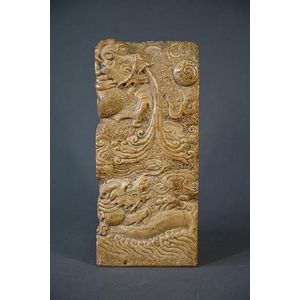17th Century Nepalese Wooden Strut with Vasundhara Goddess
A Nepalese carved wooden temple strut, circa 17th century, depicting the four armed Vasundhara goddess of abundance, wearing a long garland and holding her identifying sheaf of wheat, standing, her legs gracefully crossed at the knee She stands beneath stylised leaves, above a kneeling donor figure (possibly a Malla king), three lines of Newari script to the lower part of the strut, 91 cm high, similar example please see Christie's Paris, 19, Dec., 2012, lot 108
You must be a subscriber, and be logged in to view price and dealer details.
Subscribe Now to view actual auction price for this item
When you subscribe, you have the option of setting the currency in which to display prices to $Au, $US, $NZ or Stg.
This item has been sold, and the description, image and price are for reference purposes only.
- Floral Swag / Garland / Festoon - Floral swags are a decorative motif often used in the ornamentation of various objects, such as silverware, glassware, and furniture. The term "swag" refers to a garland or wreath of flowers, foliage, or other decorative elements, which is usually arranged in a loop or curve.
Floral swags can be found in a variety of decorative styles, from ornate Baroque and Rococo designs to more naturalistic Art Nouveau and Art Deco styles. They are often used to add a touch of elegance, refinement, or whimsy to an object, and can be seen on a range of items from chandeliers and candlesticks to picture frames and tea sets.
In the decoration of silver objects, floral swags are often used to accentuate the curves and lines of the piece, and to add visual interest to the surface. Similarly, on glass objects, floral swags may be used to frame or highlight a particular area of the object, or to add a touch of color and delicacy.
On furniture, floral swags can be found on a variety of pieces, from cabinets and armoires to chairs and sofas. They are often used to enhance the lines and curves of the furniture, and can be used to create a sense of movement and flow in the design.
Overall, floral swags are a versatile decorative element that can be adapted to a range of styles and applications, and have been used in the decoration of various objects throughout history. - Circa - A Latin term meaning 'about', often used in the antique trade to give an approximate date for the piece, usually considered to be five years on either side of the circa year. Thus, circa 1900 means the piece was made about 1900, probably between 1895 and 1905. The expression is sometimes abbreviated to c.1900.
Visually similar items

Carved architectural element, dominant tiki figure, heavily carved double haehae and dog tooth notching. Dry red washed patina with traces of white paint to teeth. Length 154 cm. Width 26 cm. Diameter 2.5 cm
Sold by
in
for
You can display prices in $Au, $US, $NZ or Stg.

A Chinese carved bamboo brush pot, 14.6 cm high
Sold by
in
for
You can display prices in $Au, $US, $NZ or Stg.

Large Chinese soapstone seal. Carved dragon to four sides. Character seal to base H28 cm
Sold by
in
for
You can display prices in $Au, $US, $NZ or Stg.

A pair of carved Chinese ivory panels on stands, depicting ladies in a landscape setting. Height 23 cm each
Sold by
in
for
You can display prices in $Au, $US, $NZ or Stg.
